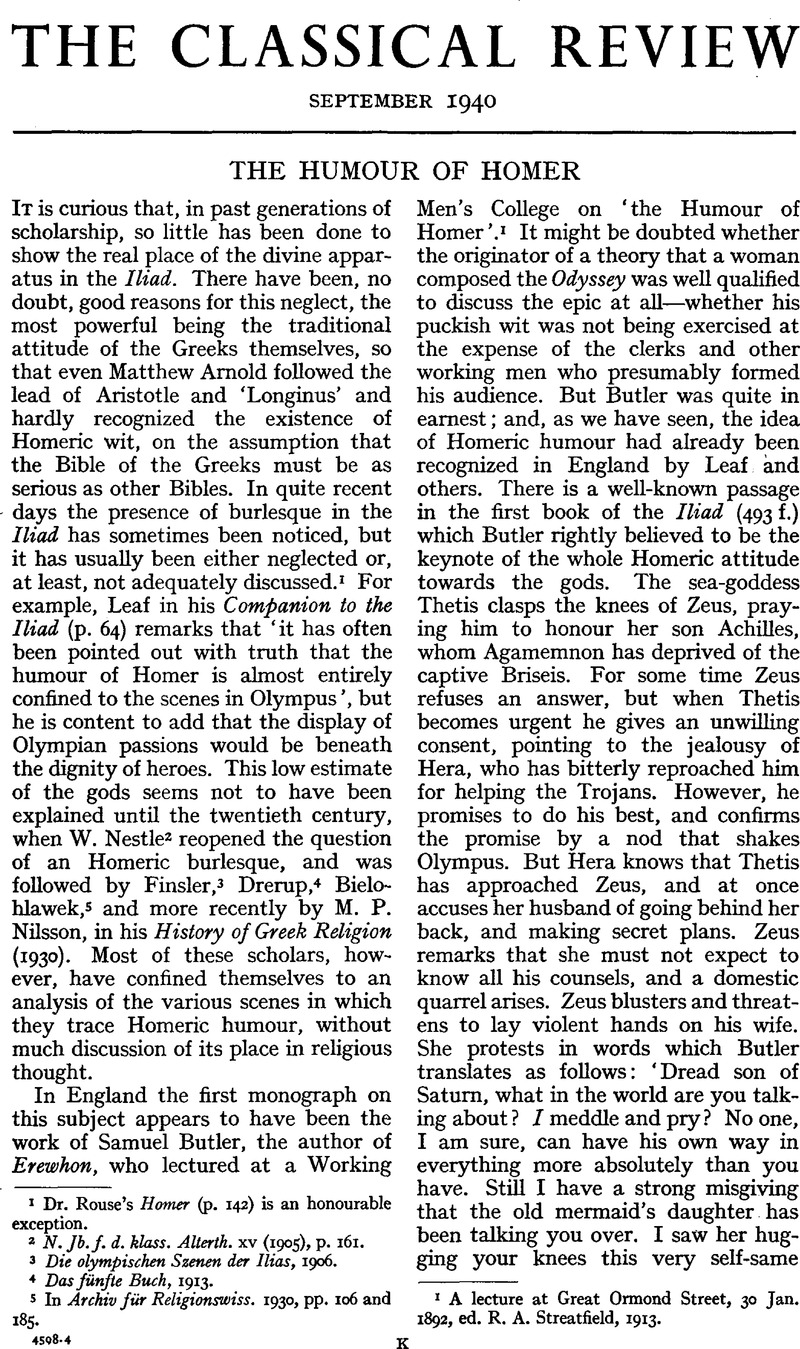No CrossRef data available.
Published online by Cambridge University Press: 27 October 2009

page 121 note 1 Dr. Rouse's Homer (p. 142) is an honourable exception.
page 121 note 2 N. Jb.f. d. klass. Allerth. XV (1905), p. 161.Google Scholar
page 121 note 3 Die olympischen Szenen der Mas, 1906.
page 121 note 4 Dasfiinfte Buck, 1913.
page 121 note 5 In Archiv fur Religionswiss. 1930, pp. 106 and 185.Google Scholar
page 121 note 1 A lecture at Great Ormond Street, 30 Jan. 1892, ed. R. A. Streatfield, 1913.
page 122 note 1 Dr. Rouse defends his position in Homer (1939) ch. x.
page 122 note 1 Il. 18. 410.
page 122 note 2 H. Bergson, Laughter (E.T. 1913), pp. 8 f. Bergson was here anticipated by Hobbes (Humane Nature): ‘To see another fall is disposition to laugh.’
page 122 note 3 Desmond MacCarthy in The New Statesman, 29 Jan. 1938.
page 123 note 1 Cf. 20. 66 f.
page 123 note 2 Ibid. 21. 389.
page 123 note 1 M. P. Nilsson, History of Greek Religion, pp. 33 f. S. E. Bassett (Poetry of Homer, p. 224) doubts any allusion to the ![]() .
.
page 124 note 1 Aen. vii. 116.
page 124 note 2 237.
page 124 note 3 Aen. i. 740.
page 124 note 4 Certain Italian epics are exceptions; see Dixon, W. Macneile (English Epic and Heroic Poetry, p. 146), who mentions Ariosto, Pulci, Tassoni, and Forteguerri in various types of seriocomic or burlesque.Google Scholar
page 125 note 1 Scott, J.A., The Unity of Homer, pp. 178 f.Google Scholar
page 125 note 2 See generally G. G. Coulton, From St. Francis to Dante, and elsewhere. Hewitt, J. W. (A.J.P. xxxviii, 1917, pp. 176–185)Google Scholar discusses the ‘irreverence’ in Aristophanes, with parallels in the medieval banter of St. Peter and other saints, and even of God.
page 125 note 1 A. W. Pollard, English Miracle Plays, &c., pp. xl f.
page 125 note 2 Dr. Rouse (Homer, p. 142) mentions the attitude of European peasants towards their patron saints: ‘the sailor was not above beating the image of St. Nicholas if storms ran too high.’ He might have added Theocr. vii. 106 (Arcadian boys beating Pan).
page 125 note 3 Ker, W. P., Epic and Romance, p. 49.Google Scholar See generally Chadwick, H. M., Heroic Age, and (with N. K. Chadwick) Growth of Literature, i, pp. 245 f.Google Scholar; Phillpotts, B., Edda and Saga, pp. 108 f.Google Scholar
page 126 note 1 See Gardner, E. A., Handbook of Greek Sculpture, i, pp. 158 f.Google Scholar
page 126 note 2 Plato, Crat. 406 c.
page 126 note 1 The Poetry of Homer, p. 222.
page 126 note 2 ‘The Epic’ in The Art and Craft of Letters.
page 126 note 3 See my Roman Poetry, p. 206.
page 127 note 1 Nilsson, M. P., History of Greek Religion, pp. 175 f.Google Scholar; Homer and Mycenae, p. 275.
page 127 note 2 Murray, G., Four Stages of Greek Religion, p. 76Google Scholar; Rise of the Greek Epic, pp. 281 f.